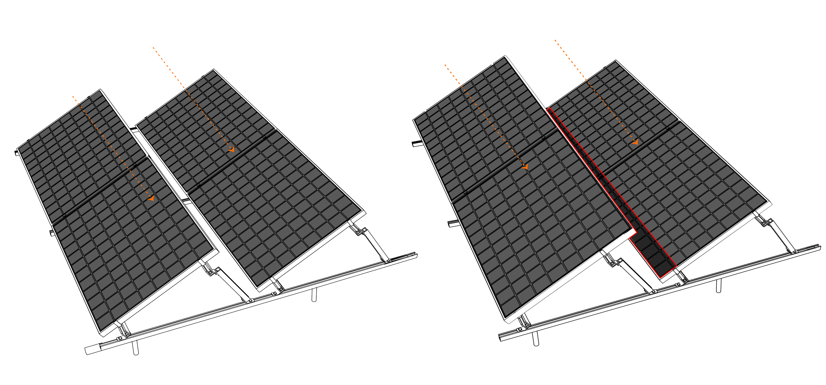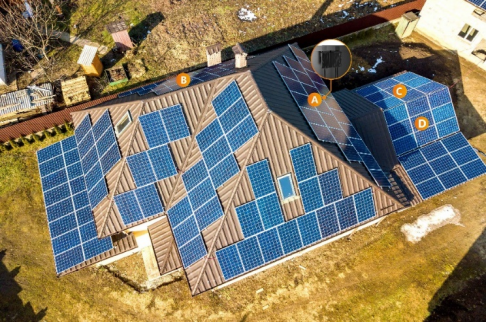n the practical application of photovoltaic power generation, problems such as shadow occlusion, module orientation difference, and module attenuation often lead to a decrease in system power generation. Studies have shown that shadow occlusion can lead to power generation loss of up to 70% (source ①: NREL). Especially when a certain module is shaded, the current and power output of the entire series circuit will be greatly reduced. Therefore, the photovoltaic optimizer came into being. It adjusts the output current of the problem module through the internal DC-DC control circuit to achieve current matching with other modules, effectively reducing the power generation loss caused by mismatch. Next, this article will explain in detail the specific application requirements of the photovoltaic optimizer and the solutions it provides in the stock power station and the newly installed power station.
Key measures to increase the power generation of existing power stations
For photovoltaic power plants already in operation, the installation of photovoltaic optimizers is undoubtedly a crucial upgrade strategy. This technology can not only significantly increase the power generation of the system, but also provide a strong guarantee for the long-term stable operation of the power plant. Here are some typical application scenarios:
Old power station renovation (without replacing new modules)
Some old power stations that have been in operation for many years often experience a decline in power generation due to module aging, performance degradation, and changes in the working environment. According to studies, the power generation efficiency of aging modules can be reduced by up to 20% (Source ② 1: IEA), causing serious module mismatch problems. Installing an optimizer can not only solve this problem and recover the lost power generation to the greatest extent, but also monitor the working status of modules in real time through module-level monitoring functions, accurately locate problem modules, and save operation and maintenance time.
Old power station renovation (all replaced with new modules)
For power stations that are usually completed in 2018 or before, it is planned to replace the old modules with the latest modules. When replacing new modules, shadow occlusion (as shown in the figure below) may be caused by module size changes, resulting in power loss. According to Shenggao's project experience, systems using optimizer technology can significantly increase the comprehensive power generation in the face of shadow occlusion, with an average increase of 15% or more.

The modules of the power station completed in the past are smaller in size and replaced with larger new modules, resulting in certain shadow occlusion.
Old power station renovation (partial replacement of new modules)
With the rapid development of module manufacturing, when the modules of an old power station need to be replaced due to damage, they often face the dilemma that the original manufacturer will no longer produce the same specification modules. If only the damaged modules are replaced with the popular modules on the current market, the mismatch problem may occur in the same module string. To solve this problem, installing an optimizer has become a more economical and effective choice, which can effectively eliminate mismatches and ensure power plant efficiency.
Shadow governance
The lifespan of photovoltaic power plants is usually up to 25 years, and the surrounding environment may change during operation. For example, new buildings, transplanted trees, and new equipment on the roof may cause shadow occlusion problems for photovoltaic modules. In this case, the application of an optimizer is particularly important. By adopting optimizer technology, the impact of shadow occlusion on the power generation of the system can be significantly reduced, and the power loss caused by shadow can be recovered.
Optimal configuration suggestions for newly installed power stations
For users who have not yet installed a photovoltaic power station, it is also of great significance to configure the photovoltaic optimizer prospectively. At the beginning of the planning and design of the power station, the optimizer should be taken into account to ensure that the power station has an efficient, stable and intelligent power generation capacity from the beginning of construction. The following scenarios are particularly suitable for the installation of photovoltaic optimizers:
Complex roof structure
At the beginning of the construction of a PV plant, one of the core factors that determine the scale of rooftop PV installations is the orientation of the roof. Modules in the same string face in two different directions, resulting in a certain power loss. The PV optimizer allows each module to operate at its maximum power point, independent of other modules in the same string, thus maximizing the use of roof area.

Shadow occlusion problem
The presence of shadows around the roof can cause the power generation loss of the photovoltaic system. Even the slightest shade from trees or wires can have a significant impact on the power generation of the entire plant. The PV optimizer uses module-level MPPT maximum power tracking to independently optimize the blocked modules and increase the overall system power generation.
The natural environment is changeable
Common environmental factors such as ash accumulation, bird droppings, and snow accumulation can also have a significant impact on the power generation of photovoltaic power plants. If the natural environment in the area where your roof is located is volatile, it is likely that photovoltaic power generation will not meet expectations. Installing an optimizer can effectively address these challenges and ensure stable power generation.
Safety and maintainability requirements
Photovoltaic systems have the characteristics of continuous voltage generation. In the event of malfunctions, fires and other critical situations, photovoltaic systems that cannot be safely cut off at low voltage will have potential safety hazards. The photovoltaic optimizer can detect latent risks in time through module-level monitoring and complete rapid shutdown within 15 seconds, reducing the voltage to a safe level to ensure the safety of photovoltaic systems and operation and maintenance personnel.
To sum up, PV optimizers play an important role in increasing the power generation of PV systems, ensuring safety and ease of maintenance. Whether it is an operating or uninstalled PV power plant, it is a wise choice to install optimizers in specific scenarios.
source ① NREL PV Performance :https://www.nrel.gov/docs/fy19osti/72399.pdf
source ② IEA Photovoltaic Power Systems Programme : https://iea-pvps.org/